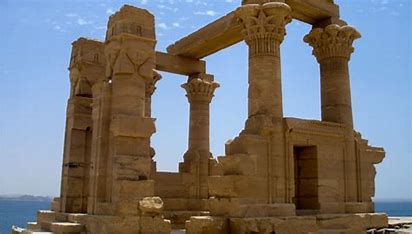A day trip to the Philae and Kalabsha Temples, combined with a visit to the Nubian Museum in Aswan, is a captivating journey into the heart of ancient Nubian civilization. These sites offer a glimpse into the rich history, culture, and architectural brilliance of a region that once thrived along the Nile. Here’s what you can expect from this unforgettable experience:
1. Philae Temple: The Jewel of the Nile
The day begins with a visit to the stunning Philae Temple, dedicated to the goddess Isis, one of the most important deities in ancient Egyptian religion. Located on Agilkia Island, the temple was originally situated on Philae Island but was meticulously relocated to its current location during the UNESCO rescue mission in the 1960s to save it from the rising waters of Lake Nasser after the construction of the Aswan High Dam.
- Historical Significance: The temple complex dates back to the Ptolemaic and Roman periods (around 300 BCE to 300 CE), though its origins trace even further back to the 26th Dynasty. It served as a major center for the worship of Isis and was a pilgrimage site for centuries.
- أبرز: The temple features beautifully preserved reliefs, including depictions of Isis, Osiris, and Horus, as well as Roman emperors making offerings to the gods. The Kiosk of Trajan, with its elegant columns, is a standout feature.
- Atmosphere: The serene island setting, surrounded by the Nile’s blue waters, adds to the temple’s mystical charm.
2. Kalabsha Temple: A Testament to Nubian Heritage
Next, head to Kalabsha Temple, located near the High Dam. This temple is one of the largest free-standing temples in Nubia and was also relocated during the UNESCO campaign. Dedicated to the Nubian sun god Mandulis (a local form of Horus), the temple was built during the Roman era under Emperor Augustus.
- Historical Significance: Kalabsha Temple showcases a blend of Egyptian and Roman architectural styles. It was constructed on the site of an earlier structure from the 18th Dynasty of the New Kingdom.
- أبرز: The temple’s well-preserved reliefs depict Roman emperors as pharaohs, offering gifts to the gods. The Nilometer, used to measure the Nile’s water levels, is another fascinating feature.
- Cultural Insight: The temple provides a unique perspective on the syncretism of Egyptian and Nubian religious practices.
3. Nubian Museum: A Treasure Trove of Nubian Culture
The final stop of the day is the Nubian Museum, a modern institution dedicated to preserving and showcasing the history and culture of Nubia. Opened in 1997, the museum is a testament to the resilience and creativity of the Nubian people.
- Historical Significance: The museum houses artifacts spanning thousands of years, from prehistoric times to the modern era. It highlights the impact of the Aswan High Dam on Nubian communities and the international effort to save Nubian monuments.
- أبرز: The exhibits include statues, pottery, jewelry, and tools from ancient Nubian kingdoms like Kush و Meroe. A replica of a traditional Nubian house offers insight into the daily life and architecture of the region.
- Cultural Insight: The museum also emphasizes the importance of Nubian language, music, and traditions, ensuring that this vibrant culture is not forgotten.
Why This Day Trip is Unforgettable
This day trip is more than just a tour of ancient sites; it’s a journey through time. From the spiritual allure of Philae Temple to the grandeur of Kalabsha Temple and the cultural richness of the Nubian Museum, you’ll gain a deep appreciation for the history and heritage of Nubia. The temples’ relocation stories also highlight the global effort to preserve humanity’s shared cultural legacy.
Whether you’re a history enthusiast, a culture lover, or simply someone seeking beauty and inspiration, this day trip offers an unforgettable experience that connects you to the timeless wonders of the Nile.
أسوان هي مدينة في Southern Egypt, and is the capital of the Aswan Governorate.


